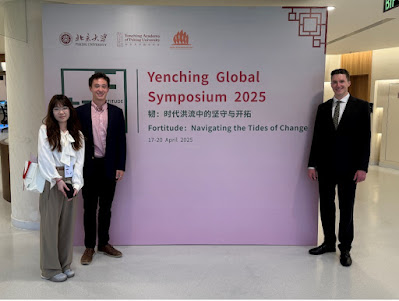Student blogger Cady Deck, Certificate ’19, shares her experience participating in a student-led research trip to the China- Myanmar border for the China on the Border: Provincial Relations on the Periphery course. Other student groups planned trips to China’s borders with Russia and North Korea.

During the spring semester, I took China on the Border: Provincial Relations on the Periphery, which is a class about China’s relations with its neighboring countries. After taking Chinese and American Thought: Bilingual Perspectives in the fall, I was looking forward to another course that involved both field research and opportunities to collaborate with my Chinese classmates. Similar to the Bilingual Perspectives class, the China on the Border class also has a fairly even mix of Chinese and international students. We started the semester with a historical background of the region and international relations theories specifically related to border management before moving on to China’s specific relationships with other countries such as Russia, Myanmar, and North Korea.
In addition to class lectures and discussions, a significant part of this class is to design and plan a research trip to a border region. The class split up into several groups, depending on what (and which) region students wanted to study. Two groups went north, either to Jilin and Liaoning provinces or to Heilongjiang province, and one group (my group) went south to Yunnan province. After determining our groups, we came up with our own individual research proposals related to the border region. My group chose to research Yunnan-Myanmar relations. Two students were interested in analyzing dam diplomacy in Myanmar, two students wanted to examine the prevalence of animal trafficking across the border, and two students decided to research vulnerable populations, including human trafficking victims and refugees from Myanmar. The groups that went north also had a variety of topics related to either China-North Korea relations or to China-Russia relations.
After developing our topics, each group began the labor-intensive project of planning exactly where to go, how to get there, where to stay, and what to do once we arrived. My group spent many afternoons and late nights navigating these decisions as we all had different topics that we wanted to study. After settling on several locations and determining our modes of transportation and lodging, we researched the specific places to go and reached out to people for interviews. My team decided to go to Kunming first to interview professors and students at Yunnan University before heading to Ruili, a border town on the Yunnan-Myanmar border, to conduct more in-depth field research.
Yunnan Group (China-Myanmar Border) In Kunming, we conducted several interviews, including one with Yunnan University graduate students about border residents in Yunnan. We also organized a private guided tour with Kunming’s Wildlife Zoo media representative to learn about rescued animals. Although unplanned, wandering around downtown Kunming talking to local shopkeepers about our topics was quite helpful and gave us an idea of what to expect when we went to the border town of Ruili.
 |
| Interviewing graduate students at Yunnan University about border residents on the China-Myanmar border | | |
 |
| Visiting the Kunming Wildlife Zoo |
 |
| Talking to a local traditional Chinese medicine shopkeeper |
Our next stop was Ruili, where we hoped to gain first-hand knowledge of our topics. We visited the Jiegao border port, interviewed people in the supermarket, and learned about a variety of activities happening at the border. We also went to “一寨两国” (One Village Two Countries), which is a half-Chinese, half-Burmese village split down the middle by the national border. We went there to learn about the close cross-border connections between peoples, cultures, and trade in the border region. One of my favorite parts was visiting Yinjing primary school. I had done a lot of reading about cross-border education and this school stood out as one of the shining examples of cross-border education initiatives. The school is composed of both students from Myanmar and China, most of whom are ethnically Dai. We talked with students about their experience at the school and how they interacted with their peers across the border.
 |
| View of Myanmar from the Jiegao Border Port |
 |
| Chatting with a few women from Myanmar |
 |
| Standing on the China-Myanmar border |
 |
| Talking with students at a local primary school |
The other two groups also had exciting trips to the China-North Korea border and the China-Russia border. Below are some highlights from the students who participated on those trips.
Jilin-Liaoning Group (China-North Korea Border): Members from this group researched cross-border trade, tourism, branding, and seafood imports.
 |
| Students visited Yanbian University to discuss tourism between China, North Korea, and South Korea |
 |
| Visiting the Hunchun Border Economic Cooperation Zone |
 |
| Visiting the Dandong International Ferry Company |
Heilongjiang Group (China-Russia Border): Students researched logging on the China-Russia border, the Belt and Road Initiative, and the 代购 (
daigou, or a person who buys products abroad on client’s behalf) business, along with several other topics.
 |
| Interviewing an Oroqen (鄂伦春族) woman in her house to learn about Oroqen traditions, culture, and survival in northern China |
 |
| Students standing next to the Heihe-Blagoveschensk Bridge, a Sino-Russia joint development project |
 |
| Conducting an interview at Boris Economic and Trade Co., ltd |
Taking collaborative classes that have both Chinese and international students has been one of the best parts of my Hopkins-Nanjing Center experience. In addition to making some of my best friends in these classes, I also engaged in meaningful discussions with my Chinese classmates in an academic setting that is only possible at a place like the Hopkins-Nanjing Center. Participating in research fieldtrips both semesters encouraged me to develop and pursue interests in specific topics and regions, such as ethnic minorities (fall semester) and China-Myanmar relations (spring semester), while also teaching me about field research techniques that I hope to apply in the future. I highly recommend that incoming students take one of the collaborative classes offered next year!
Written by Cady Deck, Certificate ’19
















